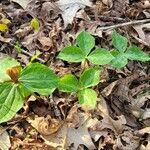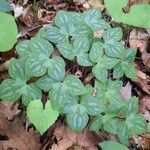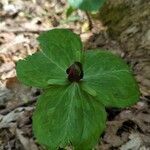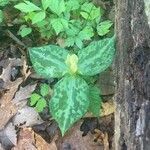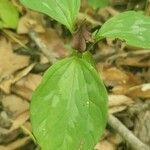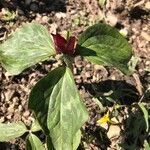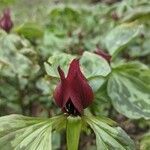Rhizome very thick and stout; stem 1–3 dm at anthesis; lvs broadly ovate to rotund, sessile, rounded, broadly obtuse or obscurely cuspidate, usually only inconspicuously or not at all mottled, seldom over 9 cm at anthesis; fl sessile, foetid; sep spreading or ascending, lance-ovate, 2–3 cm; pet normally maroon (yellow or green), ascending, narrowly to broadly elliptic, narrowed to a sessile base, equaling or slightly longer than the sep and twice as long as the stamens; filaments (2–)3–4(–5) mm, less than half as long as the introrse anthers, the flattened connective with a prolongation nearly as long as the filament; stigmas 1.5–2 times as long as the subglobose, sharply 6-angled or-winged ovary; 2n=10. Rich moist woods; w. Pa. and sw. N.Y. to s. Mich., Ill., Mo., and e. Kans., s. to Md., Va., n. N.C., n. Ala., and n. Ark. Apr., May.
More
A small plant. It grows 30 cm high and spreads 30-40 cm wide. The leaf like bracts are rounded or oval. They have dark mottling. These are often slightly drooping. They encircle the flower but seldom overlap. They are 7.5-10 cm long and 4-7 cm wide. They are pointed at the tip. The flowers have purple-red petals and sepals which are purple-red but with a green tinge.
Rich woodlands, limestone districts, calcareous soils, floodplains, riverbanks, clayey alluvium, less fertile soils, high, dry limestone woods, persists under light pasturing, 100-300 metres.
More
It is a temperate plant. They do best in cool, moist soils and in shade. They are very frost hardy. It suits hardiness zones 4-9.
